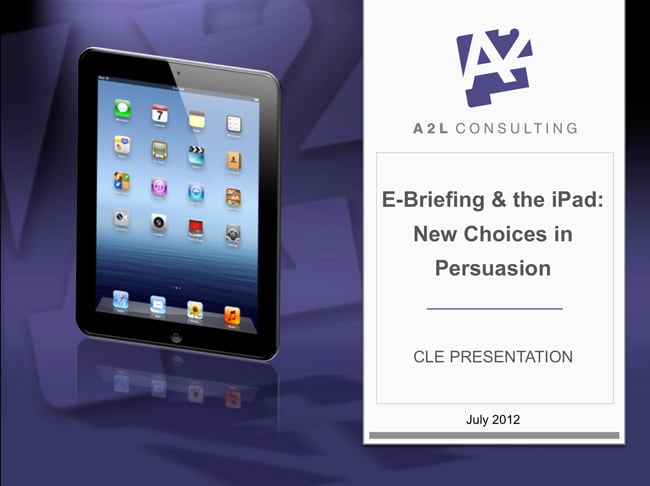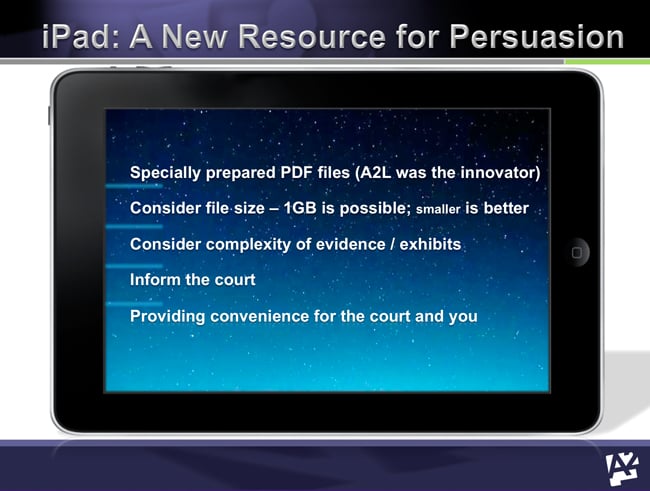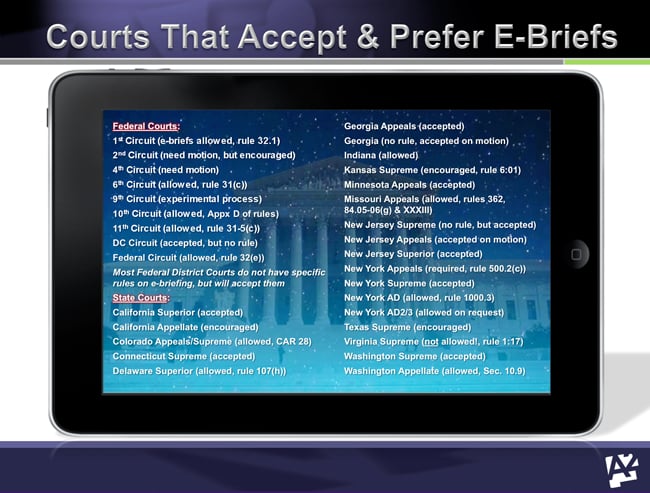Ryan H. Flax, (Former) Managing Director, Litigation Consulting
I recently participated in a CLE presentation to the chief appellate counsels of the Attorney General offices of each state in the U.S. (and a few U.S. territories) and got a big surprise.

I was there to discuss the virtues of hyperlinking briefs (aka e-briefing), a subject well covered by other A2L blog posts, but specifically focusing on designing for the iPad (and other tablets). My co-panelist preceding me in presenting actually called several judges on the phone live to ask them what technology they used when reading briefs. To my astonishment, every one of them uses an iPad to read briefs!
I knew it was common, but I had no idea it was THAT common. What a segue to my talk – I couldn’t have planned it better! Suddenly, without me having to even try, every lawyer in the room was convinced of the importance of what I was about to say.

My main points were that hyperlinked briefs/e-briefs (some even call them ibriefs) are a super persuasion tool and are a “simple” step beyond the typically court-required electronic filing for briefs and that it’s possible to design an e-brief to be specifically compatible with iPad (and other tablets) use. Doing so provides a streamlined and convenient way for you to present your arguments to the court and also allows your writing style to shine through because the reader need not put your brief down to peruse the evidence and law you’ve cited.
It’s also possible to style your writing and brief presentation to be designed with an electronic-media-reading audience in mind. Attorney Robert B. Dubose commented on this subject [PDF], "The most important lesson . . . is that screen readers usually do not read thoroughly. . . [A]lmost none of the readers read all of the words on the screen. When words are located toward the end of a paragraph, further down the page, or further to the right, they are less likely to be read."

Beyond being a terrific convenience for the court, having hyperlinked e-briefs prepared is a major convenience for you as a litigator. Imagine you’re in trial or a hearing and the subject matter of your hyperlinked brief becomes a contentious situation, e.g., you’ve filed a motion to preclude the opposing expert from straying from his report and he’s doing just that on the stand. Now you can object and approach the bench with your iPad loaded with your motion that is hyperlinked to the expert’s report, which is also hyperlinked to its own exhibits. Your objection will stand a far better chance of being sustained, and quickly, if you can show the judge exactly what the expert did and did not say in his report (instantly).
The bottom line is: because the courts’ usage of tablets is so common, if you’re not filing iPad-focused hyperlinked briefs, you’re leaving a persuasive tool in the shed. You can find a sample of such an e-brief here http://www.a2lc.com/download-sample-ebrief/
Materials Related to Hyperlinking Briefs on A2L Consulting's Site:
How to hyperlink a brief?
How can I learn more about A2L's ebriefing services?
Who produced one of the first iPad compatible hyperlinked briefs?
What is new with ebriefs?






Leave a Comment